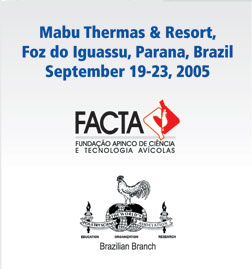Contributed Papers: Oral Presentations
Molecular biology and Biochemistry |
Characterization
of Serine Proteases in Developmental Stages of Eimeria
tenella
R.H. Fetterer, K.B. Miska, P.C. Allen, H. Lillehoj
and R. C. Barfield.
Animal Parasitic Disease Laboratory,
Animal and Natural Resources Institute,
USDA, ARS, Beltsville, Maryland. USA.
rfettere@anri.barc.usda.gov
Because of the importance of enzymes of the serine
class as targets for novel controls of human diseases,
the current study investigates the occurrence and
function of serine proteases in Eimeria tenella developmental
stages. Using gel electrophoresis with casein imbedded
gels (zymograms), bands of proteases activity with
relative molecular weights (Mr) of 15, 24, 40 and
90 kDa were observed in soluble extracts of oocysts
following 0, 12, 24, 48 and 72 hr of sporulation.
Inhibition of the activity by serine protease inhibitors
suggests that the observed proteolysis was the result
of a serine protease. Purification of the proteolytic
activity from unsporulated (0 hr) oocysts by affinity
and anion exchange chromatography yielded a protein
with an Mr of 24 kDa. Assessment of proteolytic activity
from in vivo derived merozoites (MZs) demonstrated
a similar pattern of proteolytic activity as seen
for oocysts. Excretory/secretory (ES) products obtained
from MZ after 3hr in culture at 41 C were enriched
10 fold in serine protease activity compared to MZ
extract. In contrast, proteolytic activity from soluble
extracts of sporozoites (SZs) contained only a single
band of serine proteases activity (24 kDa), but ES
had little protease activity. The invasion of E. tenella
SZs into cultured cells was inhibited by the irreversible
serine protease inhibitor, AEBSF, in a dose-dependent
manner. AEBSF (1mM) also inhibited the release of
the microneme protein MIC2 by SZs into the cell culture
media suggesting that AEBSF prevents cell invasion
by inhibition of a serine protease involved in the
release or processing of micronemes. Searches of the
E. tenella genome for enzymes homologous to the serine
protease class indicated that trypsin-like enzymes
are absent, but enzymes related to bacterial subtilisins
and a rhomboid protease are present in the genome.
Consistent with this finding, analysis of transcripts
expressed by E. tenlla oocysts using substractive
hybridization methods indicate the presence of two
serine protease, a subtilisin and a rhomboid protease.
These findings together suggest that serine proteases
are widely distributed in E. tenella developmental
stages. The enzymes function during sporulation is
unknown, but a serine protease may be important for
sporozoite cell invasion.
